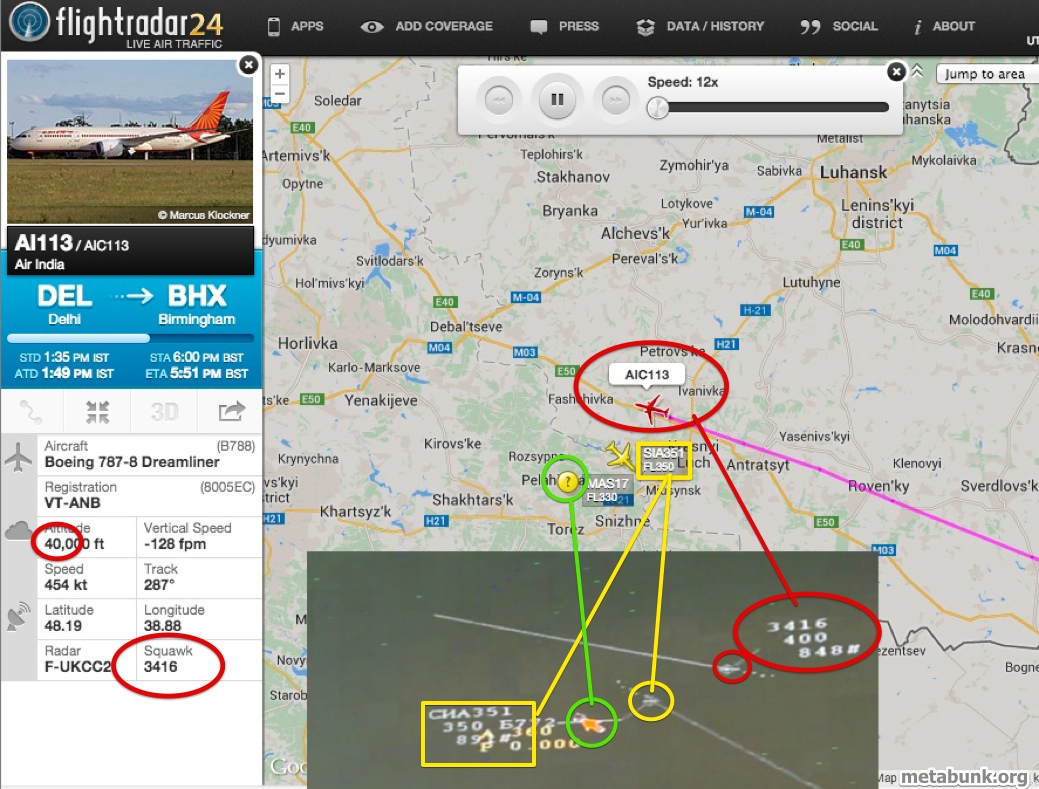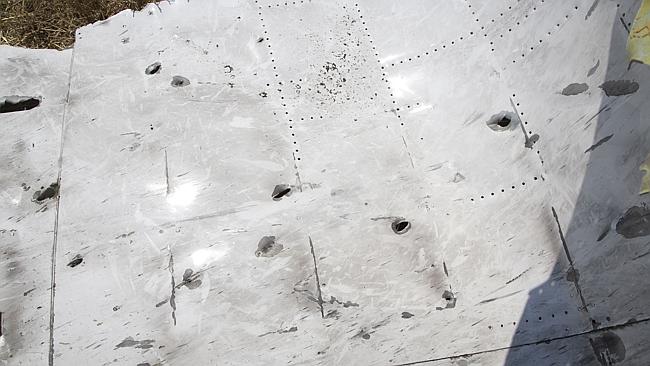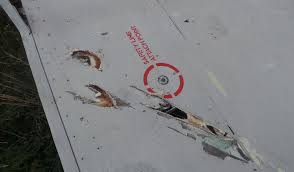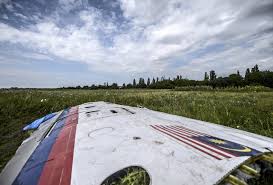You are using an out of date browser. It may not display this or other websites correctly.
You should upgrade or use an alternative browser.
You should upgrade or use an alternative browser.
Debunked: MH17 Air to air missile Assumption ? [Unrelated 35° angle]
jonnyH
Senior Member.
CNA351 is not a fighter:
https://www.metabunk.org/threads/mh...ary-plane-flying-nearby-before-incident.3993/
Besides, to calculate the angle from radar you need to measure it between where the "fighter" was when it launched the missile and where MH17 was when the missile struck, not their contemporaneous positions.
This thread, the source of the above quote, goes into more detail:"CNA351" is Cyrillic for SIA - Singapore Airlines flight 351 - a B777-200 (b772) at 35,000 ft (350)
https://www.metabunk.org/threads/mh...ary-plane-flying-nearby-before-incident.3993/
Besides, to calculate the angle from radar you need to measure it between where the "fighter" was when it launched the missile and where MH17 was when the missile struck, not their contemporaneous positions.
Franckly
New Member
I think Singapore Airline flight 351 is "3416" on the russian screen radar.CNA351 is not a fighter:
I have read this on a Metabunk thread.
jonnyH
Senior Member.
3416 is Air India 113, again from the thread linked above:
No, it's Air India 113. The other plane is Singapore 351
Confirmed by FlightRadar24.com data.

Franckly
New Member
3416 is Air India 113, again from the thread linked above:
Thanks for your reply.
Chew
Senior Member.
Yes, the damage indicate an angle 'attack' from 35 deg with respect to the axis of the MH17.
And 13 sec before the MH17 diseappires from the radar the 'supposed fither' (CNA351 on the screen) has an 'angle attack' of 35 deg with respect to the MH 17 axis.
Are you thinking the damage was caused by a machine gun?
Franckly
New Member
Are you thinking the damage was caused by a machine gun?
Absolutely no. Perhaps by shrapnel(s) from groud-air missile or when the wing comes to the ground.
But the wing is slightly "cut" with two parralel lines.
Have you an opinion on this damage ?
Jason
Senior Member
Absolutely no. Perhaps by shrapnel(s) from groud-air missile or when the wing comes to the ground.
But the wing is slightly "cut" with two parralel lines.
Have you an opinion on this damage ?
First of all they aren't parallel lines if you look at it closely. If a proximity warhead detonated in the front of the plane, as theorized, one would expect this type of damage. If we look at the photos of the cockpit skin below the pilot window we can see how close together the shrapnel puncture holes are, here;
Then as we make our way back from the cockpit one would expect the puncture holes to space out more as the blast radiates the shrapnel outward.


Even this picture you can see minimal puncture holes from the shrapnel right below the flag

Franckly
New Member
The Jeroen Akkermans's full size picture (4608x2592 px) of the wing debris damage is here:
https://secure.flickr.com/photos/jeroenakkermans/14737382623/in/photostream/
https://secure.flickr.com/photos/jeroenakkermans/14737382623/in/photostream/
Franckly
New Member
one would expect the puncture holes to space out more as the blast radiates the shrapnel outward.
It's probably debris that was shed immediately after the aircraft was hit.
Tanks for your answers.
Are you thinking the damage was caused by a machine gun?
Absolutely no, but can the two "parallel" slightly cuts come from the "wings" or "fins" of a supposed rocket coming from behind the MH17 and gliding along the top of the wing ?
WeedWhacker
Senior Member
I do think that much of this speculation RE: missile vectors and damage assessments is a bit premature...until the full accident investigation (such as can be determined) is concluded. Experts will weigh-in to add to the final reports.
Jason
Senior Member
I agree WW, but using some intelligent deduction I think it's safe to "assume" that there should be more "shrapnel" puncture holes and closer together, the closer it was to the missile's detonation. As the fragments radiate out from the detonation the fragments will continue to "fan" out and be more spread out from one another. So one would think the closer you are to the blast the closer the puncture holes should be together and the further away from the blast the more spread out the puncture holes should beI do think that much of this speculation RE: missile vectors and damage assessments is a bit premature...until the full accident investigation (such as can be determined) is concluded. Experts will weigh-in to add to the final reports.
Elfenlied
Member
The shrapnel would have two perpendicular velocity components, the speed and direction of the missile (depends on the type, for a BUK it's about 850 m/s http://en.uos.ua/produktsiya/tehnika-pvo/75-zenitniy-raketniy-kompleks-buk ), and the velocity from the explosion (initial fragment velocity is typically 1800 to 2100 m/s http://fas.org/man/dod-101/navy/docs/fun/part13.htm ), so that would give an angle of about 60° to 70° in respect to the missile direction. Then there's the speed of the aircraft which is constant while the shrapnel slows down rapidly due to drag, making the resulting impact angle also a function of the size of the shrapnel and the distance the shrapnel traveled before it hit the plane...
WeedWhacker
Senior Member
I think it's safe to "assume" that there should be more "shrapnel" puncture holes and closer together, the closer it was to the missile's detonation.
Again, these sorts of "assumptions" do not take into account relative motions of the missile, the "target" (MH17 in this case) the approach angle OF the missile, etc, etc. It is a VERY complex set of circumstances that (alas) likely will never be fully explained/properly documented because the airliner debris field was not "secure".
Chew
Senior Member.
The speed of the missile would cause the fragments to expand in an elongated spherical shape instead of a pure spherical shape if the warhead wasn't moving. Regardless of the missile's motion, the closer an object is to the detonating warhead the more hits per square meter it would receive. It's the basic inverse square law.
Danver
Member
Absolutely no. Perhaps by shrapnel(s) from groud-air missile or when the wing comes to the ground.
But the wing is slightly "cut" with two parralel lines.
Have you an opinion on this damage ?
Rods would do that on a wing. To me it seems this missile was not a regular sa 11. It had those diamond shaped shrapnel and also Rods on its war head.. plus a second stage of explossives from that missile inside the cabin would also explain why the complete head secction was pulled off.
I do not know if a pechora can do something like this or a sa 17 ,but there is certainly more to explain.
The story about an air-to-air missile is looking harder and harder to explain ,because normally su 25s have heat seeking missiles and they would have searched for the turbines.. not the planes main body even less its nose. Also that angle described in the flight path departing from a supposed su 25 (a point shown in the Russian Radar presentation that doesnt travel sideways but up and down) ,how can a heat seeking missile go foward and then return 180 degrees to explode on the nose of the plane?
And the story about armor piercing or cannons/machine gun from the su 25 its very very difficult to believe ,since the holes and very small. I think only piercing ammo 5.56 could do holes like the ones found on the mh 17 but then its impossible to understand why some of those bullets did not go thru the complete aluminum windows frames that are made rather of a very soft material.
KAT
Active Member
That wing scrape has to be from debris.
a)the chance of a rod or a whole missile just skimming a wing exactly in the same plane is very close to zero
b) any missile that manages to do that would MISS THE COCKPIT.... the tip of the wing is level with the windshield, so anything skimming the wing can't hit way below the windshield
c) heat damage and other directional damage indicates the missile detonation was lower (about level with the engine) and to the front.

a)the chance of a rod or a whole missile just skimming a wing exactly in the same plane is very close to zero
b) any missile that manages to do that would MISS THE COCKPIT.... the tip of the wing is level with the windshield, so anything skimming the wing can't hit way below the windshield
c) heat damage and other directional damage indicates the missile detonation was lower (about level with the engine) and to the front.

KAT
Active Member
Even this picture you can see minimal puncture holes from the shrapnel right below the flag

That section is from the starboard side. It was in the first image of the crash widely posted, taken from the left side with 2 men standing on the door (near the back, in this view). The dark spots appear to be dirt or debris dents,rather than through holes.
[...]
c) heat damage and other directional damage indicates the missile detonation was lower (about level with the engine) and to the front.
I'd dispute the point about the elevation of the detonation based on the following picture that shows a detail of the cockpit floor (Port side) showing what I believe to be shrapnel puncture marks from *above* the level of the floor.
original source, Jeroen Akkermans Flickr: https://farm6.staticflickr.com/5594/14715119834_a824742e65_o_d.jpg
Danver
Member
I'd dispute the point about the elevation of the detonation based on the following picture that shows a detail of the cockpit floor (Port side) showing what I believe to be shrapnel puncture marks from *above* the level of the floor.
original source, Jeroen Akkermans Flickr: https://farm6.staticflickr.com/5594/14715119834_a824742e65_o_d.jpg
Yeap ,and those holes somehow also show the direction they came from ,i dont see holes made with pieces of ,metal flying sideways but straight down.
On the other hand.. where did all the other pieces of that cockpit go? Is the rest of the cockpit the part they sliced with diesel chainsaws?
TEEJ
Senior Member.
Most of the threads discussing the shrapnel damage are locked. Recent update from BellingCat.
https://www.bellingcat.com/news/uk-...mh17-wasnt-shot-down-by-aircraft-cannon-fire/
Su-25 Frogfoot firing cannon at Aero L-39 Albatross ground target.Presented by Arkady Mamontov, a Russian journalist who last year linked the Chelyabinsk Meteorite incident to gay activism, it promises to explore the downing of MH17 in depth, and in the preview they demonstrate the lengths they’ve gone to in their investigation by arranging to have a live fire exercise to test out cannon fire on aircraft
https://www.bellingcat.com/news/uk-...mh17-wasnt-shot-down-by-aircraft-cannon-fire/
Last edited:
TEEJ
Senior Member.
Another shrapnel story is currently doing the rounds. Documents claimed to have been hacked from the Ukrainian Defence Ministry and apparently show recovered Buk M1 warhead fragments.
http://cyber-berkut.net/traitors/0025.php
The spin on the story is that Russia doesn't operate the older M1 versions and therefore the Buk must have been fired by Ukrainian forces. This doesn't stand up as Russia still operates the older M1 missiles and in particular fires the missiles during exercises and tests. (See PPRuNe link in post)
Update
The following link to the PPRuNe post has been removed by the PPRuNE moderators
http://www.pprune.org/rumours-news/543733-mh17-down-near-donetsk-69.html#post8695193
http://www.pprune.org/rumours-news/543733-mh17-down-near-donetsk.html
http://cyber-berkut.net/traitors/0025.php
The spin on the story is that Russia doesn't operate the older M1 versions and therefore the Buk must have been fired by Ukrainian forces. This doesn't stand up as Russia still operates the older M1 missiles and in particular fires the missiles during exercises and tests. (See PPRuNe link in post)
http://rt.com/news/195128-mh17-crash-cyberberkut-leak/
According to open sources, the Russian army operates only Buk-M1-2 and Buk-M2 missile systems – the latest modified versions developed after Ukraine became independent in 1991.
The source also accused Valentin Nalivaichenko, head of the Security Service of Ukraine (SBU), of inadvertently leaking that the MH17 Boeing-777-200 crash in July was caused by an outdated missile that only Ukrainian army still operates.
Update
The following link to the PPRuNe post has been removed by the PPRuNE moderators
http://www.pprune.org/rumours-news/543733-mh17-down-near-donetsk-69.html#post8695193
http://www.pprune.org/rumours-news/543733-mh17-down-near-donetsk.html
Last edited:
Similar threads
- Replies
- 52
- Views
- 3K
- Replies
- 30
- Views
- 1K
- Replies
- 38
- Views
- 3K
Latest posts
-
Claim - UFO Crashes near Las Vegas, crash captured on Cop's Body-cam
- Latest: NorCal Dave
-
